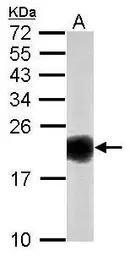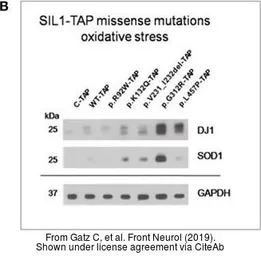SOD1 antibody

Non-transfected (–) and transfected (+) 293T whole cell extracts (30 μg) were separated by 15% SDS-PAGE, and the membrane was blotted with SOD1 antibody (GTX100554) diluted at 1:5000. The HRP-conjugated anti-rabbit IgG antibody (GTX213110-01) was used to detect the primary antibody.

Immunofluorescence photomicrographs of paraffin-embedded mouse fetal brain.
Green: SOD1 antibody (GTX100554) diluted at 1:200. The signal was developed using goat anti-rabbit IgG antibody (Dylight488) (GTX213110-04).
Red: beta Tubulin 3/ TUJ1 antibody [GT11710] diluted at 1:100. The signal was developed using goat anti-mouse IgG antibody (Dylight594) (GTX213111-05).
Blue: Nuclear staining with Hoechst 33342.
Antigen Retrieval: Citrate buffer, pH 6.0, 15 min

SOD1 antibody detects SOD1 protein by western blot analysis. Whole cell extracts (30 μg) was separated by 15% SDS-PAGE, and the membrane was blotted with SOD1 antibody (GTX100554) at a dilution of 1:1000. The HRP-conjugated anti-rabbit IgG antibody (GTX213110-01) was used to detect the primary antibody.

The data was published in the journal Heliyon in 2018. PMID: 30533548

The data was published in the journal Front Physiol in 2019. PMID: 31040795

The data was published in the journal Heliyon in 2018. PMID: 30533548

The data was published in the journal Heliyon in 2018. PMID: 30533548

The data was published in the journal PLoS One in 2016. PMID: 27537547

The data was published in the journal Sci Rep in 2017. PMID: 29215072

The data was published in the journal Sci Rep in 2017. PMID: 29215072

The data was published in the journal Sci Rep in 2017. PMID: 29215072

The data was published in the journal Reprod Biol Endocrinol in 2018. PMID: 29316934

The data was published in the journal Reprod Biol Endocrinol in 2018. PMID: 29316934

The data was published in the journal Reprod Biol Endocrinol in 2018. PMID: 29316934
-
HostRabbit
-
ClonalityPolyclonal
-
IsotypeIgG
-
ApplicationsWB ICC/IF IHC-P ELISA Sandwich ELISA
-
ReactivityHuman, Mouse, Rat, Alligator, Bird









